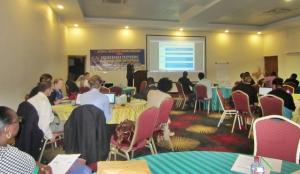Implementing the WHO End TB Strategy: Lessons from Prevalence Survey
Accra, 31 March 2015 - Ghana has just ended a two day discussions on a comprehensive response to end the tuberculosis (TB) epidemic in line with the WHO End TB Strategy. The workshop was under the theme: “Implementing the WHO End TB Strategy: Lessons from the Prevalence Survey” held in Accra from 25 to 26 March 2015.
This was organized by the NTP in collaboration with WHO, USAID, Global Fund, Stop TB Partnership and other stakeholders in TB control. The NTP together with partners will work towards strengthening the operational plan for prioritized package of interventions included in recently submitted Concept Note.
With startling revelations from the recently conducted Prevalence Survey, the NTP is to develop a technically sound implementation plan on how to reach, detect and treat the missed TB cases if the objectives of the 2015–2020 Strategic Plan are to be met. The objectives of the workshop were therefore for the technical partners and country stakeholders to better understand and agree on priority actions described in the Concept Note submitted to the Global Fund for financial assistance from 2015 to 2017.
Giving the welcome remarks, the Pro-Vice Chancellor of the University of Ghana, Professor John Gyapong gave a historical perspective to TB control and the design of the Prevalence Survey. The purpose and objectives of the workshop was presented by the Director General of the Ghana Health Service, Dr Ebenezer Appiah-Denkyira. The workshop was opened by the Chief Director of the Ministry of Health who was represented by the Director of Policy Planning, Monitoring and Evaluation, Dr Erasmus Agongo. The main resource persons were Dr Leopold Blanc, a TB consultant and a team from the Global Fund and USAID. The WHO Representative to Ghana, Dr Magda Robalo chaired the session on “The Prevalence Survey results and the current control efforts”.
Tuberculosis control in Ghana generally has progressed, with cure rates for new smear positive above the recommended WHO level of 85% in 2012. Patient defaulter rate (excluding multi-drug resistant TB [MDR-TB]) decreased from 11% in 2005 to 2.6% in 2010 (WHO target is 5%). The prevalence survey indicate a general population prevalence of 264 per 100 000 population (almost three times the previous WHO estimated 71 per 100 000 population based on country data).
Prevalence in pregnant women was incidentally found to be higher than in the general population justifying the HIV (PMTCT)–TB activities outlined in the concept note for the prioritized 90 TB highly affected districts. Prevalence for smear positive cases was 111 per 100 000 population almost in line with WHO estimates showing the programmatic success of sputum smear diagnosis however, the prevalence in bacteriologically confirmed cases by culture and molecular tests was more than three times higher, justifying new approach for intensified case finding and use of more sophisticated and expensive diagnostic methods.
The Program Manager in his presentations indicated that, the program remains challenged with low case notification at 24%, insufficient laboratory capacity, adverse outcome such as mortality particularly among prisoners and TB/HIV co-infected patients. Inadequate funding to carry out a massive effort to control tuberculosis and to treat all patients with MDR-TB is a challenge despite funding support from the Government of Ghana and the Global Fund. The meeting ended with a call on all stakeholders to increase their commitment to control and end the tuberculosis epidemic.
________________________________________________
For additional information, please contact:
Technical Contacts:
Dr Magda Robalo
Tel +233 302-763918
Email: robalom [at] who.int (robalom[at]who[dot]in)
Dr Felicia Owusu-Antwi
Tel +233 244311172
Email: owusuantwi [at] who.int (owusuantwi[at]who[dot]int)
Media Contact:
Ms Joana Ansong
Tel: +233 544316017
Email: ansongj [at] who.int (ansongj[at]who[dot]in)



